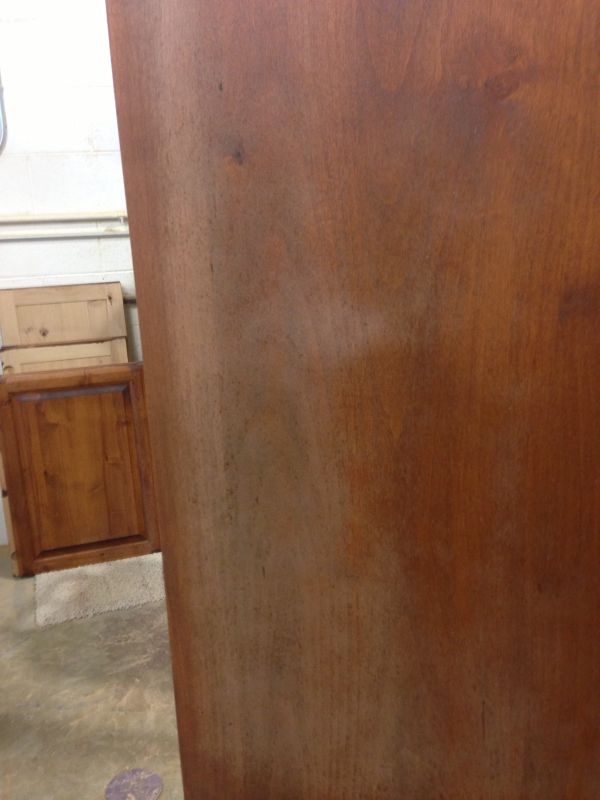Creating a dead-flat finish
Think your life is dull? It's nothing compared to *this* finish. April 4, 2001
Q.
A customer doesn't want the finish I'm doing to pick up any light. I sprayed the furniture with Campbell's Duravar dull finish, but it picks up too much light. Is there a way to dull the Duravar finish more, without recoating?
Forum Responses
This is extremely difficult to do. It's almost always easier to make something shinier than to dull it past satin without putting major scratches on it. One possible method is to use the appropriate grit of Mirka Abralon on a random orbit sander. But this isn't simple. After a certain point, dead flat is hard to achieve and shows fingerprints very easily.
Just add flatting paste or powder. Don't go much lower than a 10 degree sheen, which is usually a true "flat". When you get down to a 6 degree sheen, you've got "dead flat". Normally, the lower the sheen, the poorer the mar resistance, but not always. If you put too much flatting paste in, you may end up with a product very close to a crackle.
Bob Niemeyer, forum technical advisor
When too much flattening agent is added, scratches show up white in the coating. This can cause other problems to the resins over time.
From the original questioner:
I called my Campbell rep about the flatting paste. They don't recommend adding any paste to the Duravar, which is a 15. It could cause adhesion problems. I am hoping there is a way to dull the finish that is already on the furniture.
You could "rub" it out, but it would give you a different look. You better make up a sample and get your customer to approve it first.
When I have to flatten off a flat catalyzed finish (even pre-cat) or add a lot of colorant, I add a little extra catalyst to the finish.
If you are close to the desired sheen, the best way to solve this problem is not to do anything at all. Unless you have a high gloss finish, all finishes will flatten optically and physically over time. As the finish cures, by both solvent release and crosslinking, you will lose film volume, hence reducing the light reflectivity.
If you try to rub the finish flatter, it will look scratched before you achieve the look you are after. If you chose to re-shoot with a flattening paste, add your paste to your thinner and let it sit for a few hours and filter very well to eliminate white specks in your finish.
He would have a very long wait before it ever dulls out.
We have dulled Duravar flat with flattening paste without an adhesion problem. Make sure you are using ML Campbell's acid cured flattening paste (the stuff for the Duravar) and not the nitrocellulose type. We mixed it with thinner before adding it to the finish.
The sheen is a 15 degree. This is considered dead flat with most coating companies. In most cases, if a finish is dead flat, when you rub something across the coating, it leaves marks that will not come out. These do not have to be deep scratches--scuff marks will cause this problem. This really shows up in dead flat black finishes.
The lower the sheen, the more "burnishing", or scratch marks. But if the coating has the proper additives in it and is built to be flattened to a low sheen, it will work fine. I have sheened many a product to 10 degrees or lower, but never have gone below 5 sheen. I don't feel that 15 degrees is dead flat. The dead flats I order are 10 degrees or lower.
Remember, at these sheen levels each single digit of change is more noticeable than at 40 sheen compared to 35 sheen. Also, always spray your final sheen over full gloss to get the true sheen. Most manufacturers measure sheen on black glass, not wood.
Bob Niemeyer, forum technical advisor
The more flattening agent, the less "solids." The less solids, the more problems you will have with dead flat coatings. Some companies do use a 15 degree for their dead flat coating, just as some companies have different degrees in their gloss, satin, or flat coatings. These sheens can change in different types of coatings from the same manufacture.
Isn't a 20 sheen a 20 sheen no matter what type of coating?
Bob Niemeyer, forum technical advisor
I meant that some companies may have an acrylic flat at 25/30, and a polyurethane flat at 40/45. Their nitrocellulose coatings may have a 90/95 gloss, and their CAB gloss coatings may be 80/85. The "sheens" may not be the same in all of their coatings. There can be a difference from manufacturer to manufacturer.
I suggest SW Super Kemvar C for that dull close the wood look. You can't get a cat finish that looks more like an oil finish than that.
I use a product called Flat Lube made by Mohawk. It is applied with wet steel wool, preferably 0000, after the piece has its final topcoat and is thoroughly dry. It will dull the finish and give it a nice waxy feeling. Too much rubbing will begin to produce a shine.
